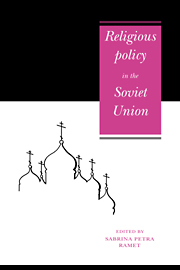Book contents
- Frontmatter
- Contents
- Notes on contributors
- Preface
- Part I Introduction
- Part II Policy apparatus
- Part III Education, socialisation, and values
- 6 Fear no evil: schools and religion in Soviet Russia, 1917–1941
- 7 Soviet schools, atheism and religion
- 8 The Ten Commandments as values in Soviet people's consciousness
- 9 Out of the kitchen, out of the temple: religion, atheism and women in the Soviet Union
- Part IV Cults and sects
- Part V The world of Christianity
- APPENDIX: Religious groups numbering 2,000 or more, in the USSR
- Index
6 - Fear no evil: schools and religion in Soviet Russia, 1917–1941
Published online by Cambridge University Press: 03 December 2009
- Frontmatter
- Contents
- Notes on contributors
- Preface
- Part I Introduction
- Part II Policy apparatus
- Part III Education, socialisation, and values
- 6 Fear no evil: schools and religion in Soviet Russia, 1917–1941
- 7 Soviet schools, atheism and religion
- 8 The Ten Commandments as values in Soviet people's consciousness
- 9 Out of the kitchen, out of the temple: religion, atheism and women in the Soviet Union
- Part IV Cults and sects
- Part V The world of Christianity
- APPENDIX: Religious groups numbering 2,000 or more, in the USSR
- Index
Summary
‘In practice, no less than in theory’, the ABC of Communism declared in 1919, ‘communism is incompatible with religious faith’. In the ensuing struggle against religion, the Party assigned schools a critical role. They were to replace religious instruction with teaching designed to counter religious sentiment among children and parents.
It was much easier said than done. Rhetoric was cheap and plenty of it followed throughout the period under study. Designing an appropriate curriculum, creating a mechanism to transmit it to the school, and implementing it in the classroom proved difficult and fraught with controversy. At the top, the Commissariat of Enlightenment, the state agency responsible for schools, found itself embroiled in a rivalry with the League of Militant Atheists, an organisation loosely associated with the Communist Party. At the middle of the educational apparatus, regional and local departments of education, especially during the 1920s, exercised an independent voice, modifying instructions from above. Finally, below, teachers, parents, and pupils resisted orders from above. They had their own reasons, some unavoidable, others laudable, and still others hardly praiseworthy.
This study examines the extent to which authorities in the Russian Republic expected primary and secondary schools to attack religion and the degree to which those schools did so. It turns out that, notwithstanding loud talk to the contrary, schools in the 1920s and 1930s were not suitable instruments for the eradication of cardinal tenets of popular belief. Active and passive resistance by officials, teachers, parents, and pupils blocked efforts at change from above. Indeed, the shoe often was on the other foot. Resistance from below contributed to a reshaping of official policy.
- Type
- Chapter
- Information
- Religious Policy in the Soviet Union , pp. 125 - 157Publisher: Cambridge University PressPrint publication year: 1992

